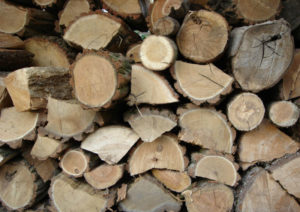FireSide Hearth & Home knows nothing is better than a warm and cozy fire inside when those cold Michigan nights lurk right outside your door. However, we want you to know when you use a wood burning appliance, regardless of where you live, it is extremely important to use properly seasoned wood.
Anatomy of Wood
Mother Earth News, the original guide to living wisely offers this lesson, “Wood is essentially a mass of tiny long tubes, or cell cavities, that run the length of the tree. Moisture exists both as “free water†in these cavities and as molecular water that is locked in the cell walls. When a tree is felled, the slow process of drying begins, and the free water is the first to evaporate. Once the free water evaporates, the moisture content of the wood is around 30 percent. This is called the ‘fiber saturation point.’ After this, water begins to leave the cell walls, and the wood starts to shrink and crack. For optimal burning, firewood should be dried, or “seasoned,†until its moisture content is less than 20 percent.
When Is Wood Considered Seasoned?
There are several ways to know whether wood is properly seasoned. Seasoned wood must be dried for at least 6-12 months in a dry place sans moisture from rain, snow, ice. As it dries, the wood it should be stored covered and off the ground. When you compare non-seasoned wood to seasoned wood, you will be able to see various distinctions. Seasoned and green wood have totally different smells, weights, sounds, and appearances. Non-seasoned wood has a damp fresh smell, is heavier in both weight and sound, and appears green under its bark. In comparison, seasoned wood is much lighter (the moisture has been drawn out), the bark easily lifts off or is no longer attached, and when you thump the pieces, seasoned wood sounds hollow.
Why Seasoned Wood?
Wood that is still green and has a high moisture content impacts both the efficiency of your wood burner as well as your health and safety. Green wood does not burn as hot as seasoned wood. Fires that are not burning hot enough cause creosote to build up. Creosote is extremely combustible; built up creosote can quickly and unexpectedly ignite and put you, your family, and your home in a fire hazard situation. There are also health considerations as creosote and carbon monoxide as by-products of burning unseasoned wood present potential life ending consequences. Did you know that mold accumulates in unseasoned wood and that mold (a known serious health hazard) is dispersed throughout your home when it is burned.
Green wood also causes damage to your appliance. Water does not burn and if the wood you are using has a high moisture content, your appliance must work extra (and inefficiently) hard to draw heat from the wood. As a result burning improper wood also affects the functionality and longevity of your appliance, as well as necessitates the need for more frequent inspections and cleanings.
To summarize, we encourage everyone with a wood burning appliance to heed the message from the Environmental Protection Association in their pamphlet “Wet Wood Is A Waste- Burn Dry Firewood to Save Money and Healthâ€.



